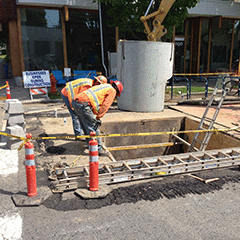All companies engaged in construction type activities (you don't necessarily need to be a construction company to be considered performing construction work) are required to have an accident prevention program. This requirement is mandated by 29 CFR 1926.20(b). According to the regulation, their are four required components of the accident prevention program.

Required Parts of an Accident Prevention Program
Part 1 - Initiate and Maintain an Accident Prevention Program
1926.20(b)(1) requires employees to initiate and maintain an accident prevention program that facilitates compliance with regulations. It does not specifically say that the program has to be written, but it is much more difficult to prove the existence of a satisfactory program if you don't have it on paper.
Part 2 - Frequent and Regular Inspections
The competent person is an important role for maintaining safety on a construction site. 1926.20(b)(2) requires a system for frequent and regular inspections, by a competent person, to make sure the job site, materials, and equipment are safe and in good working order.
Part 3 - Compliant Machinery, Tools, Equipment and Materials
Everything used on a construction site must be compliant with safety regulations. If it is not compliant, it may not be used. 1926.20(b)(3) requires the employer to remove them from service with any of the following means:
- Tagging them out
- Physical locking to render them inoperable
- Removing them from the workplace
Part 4 - Training & Experience
1926.20(b)(4) mandates that only employees with proper training or experience may operate equipment or machinery. This training requirement is one of the most overlooked rules in construction. The training and / or experience should be documented for every employee.
Recommended Products
Construction Safety and Health Program
References
29 CFR 1926.20 - General Safety and Health Regulations for Construction

2 comments
Oklahoma City Stucco
This article does a great job breaking down the essential components of a construction accident prevention program. I appreciate how it highlights the importance of thorough training and frequent site inspections. It’s clear that investing in a strong prevention program benefits everyone, from workers on-site to contractors managing the project.
As a contractor working with stucco applications, I’m especially mindful of potential safety risks associated with handling specific materials and working at elevated heights. The guidance on personal protective equipment (PPE) and hazard communication aligns well with industry needs, but I’d be interested in learning more about any specific considerations for managing airborne particles in stucco application, particularly silica dust.
Would you recommend any additional resources or best practices specifically for mitigating hazards related to stucco materials in a construction accident prevention program?
Eli Richardson
It’s great that you talked about how only employees with proper training may operate equipment or machinery in construction. Next summer, my uncle’s starting a construction project, and I think he’d benefit from reading your safety guide to prevent an accident. I appreciate your advice on documenting your employees’ training and experience. https://natl-safety.com/qualified-rigging-and-signal-person-safety-training/